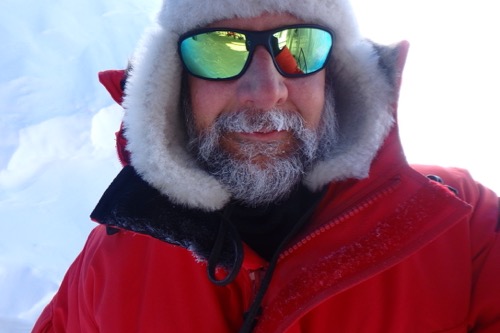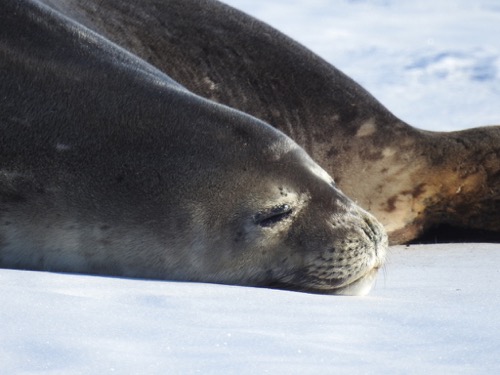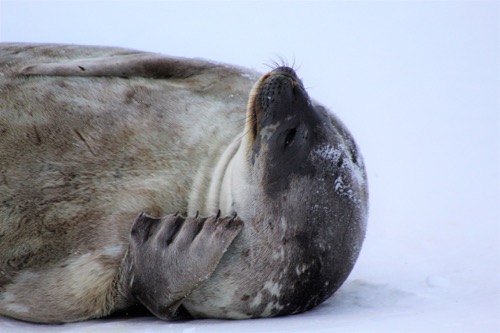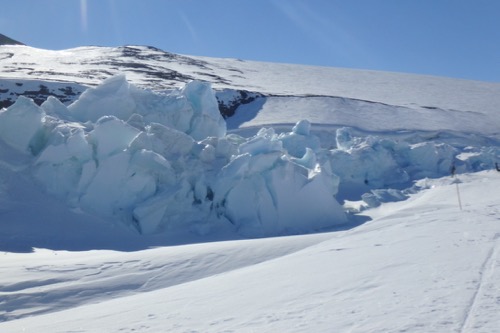I had my PolarConnect event today! Lee Wellhouse and I were able to call in on a VOIP connection. Sadly we couldn't connect with a video feed because of some internet limitations. It was GREAT to connect with everyone and I'm totally flattered by how many people and classrooms (far and wide) were able to join us!
Below are some questions that, because of time, we were not able to answer at the event so here you go! (There are more, so in the next journal I'll tackle a few more!
I received one question from a student that was almost a challenge to prove that I am really at the South Pole. I made the attached YouTube video to explain (using Trigonometry) how I KNOW that I'm at the South Pole. (Don't be scared, all of you can handle some exciting and basic Trigonometry!
Click the "Media" tab to see the YouTube video.
Do you feel the snow or ice move under you, such as tremor or an earthquake? Zenon C. 6th grade
Zenon, I haven’t felt that yet and I don’t think I want to! There are some scientists here at the South Pole who are Seismologists. They are very interested in the movement of the ice as it slides slowly on its 100,000-year journey to the ocean. They are also interested in the movement of the ground under the 9,300 feet of ice! They are also interested in one more thing, and I was surprised by this. Their equipment is also used by the “International Test Ban Treaty” to detect when (and where) nations detonate nuclear weapons because the detonation is strong enough to send shock waves all over the globe!
In Antarctica do you have to wear all your gear 24/7 like when you sleep or when you are on a plane? Jesse H. 6th grade
Jesse, it depends on where we are. Right now, I’m at the South Pole and it is really cold outside but I’m inside the station. It isn’t toasty warm in here either, so I’m dressed to be warm, but I’m not wearing all of my Extreme Cold Weather gear. BUT, when we are out at a remote location like I’ll be later this week I’ll be dressed in ECW gear virtually all of the time. Out at that location, near where the coldest ever temperature on earth was recorded, it will be about -40˚F (around -60˚F with the windchill). THEN, I’ll be in ECW all of the time.
How is it to eat? You mentioned earlier how it could freeze easily. Lilly M. 6th grade
Lilly, It hasn’t been a problem…so far. It really hasn’t been that cold out when I’ve had to eat outside. The coldest it has been when I’ve eaten outside is about -25˚F and while cold, isn’t cold enough to make the food freeze as I’m taking it to my mouth. Later this week, when I’m out at one of the coldest places on earth, it will be about -40˚F (without a windchill). Then eating will be a problem! One of the ways that we avoid the issue altogether is that when we DO eat outside we tend to eat dry foods like crackers and granola bars. Since they don’t have much moisture (water) they don’t solidify in the extreme cold temperatures.
 It is cold enough for my breath to freeze on my beard and mustache!
It is cold enough for my breath to freeze on my beard and mustache!
If my mustache will freeze, so will my piece of pizza!
What is the most fun or exciting thing you have done so far? Jack C., Jocelyn P., & Lacy P. 6th grade
Jack, Jocelyn and Lacy, That is a tough question, I’m not sure that I can narrow it down to just one. “Walking around the world” and stepping from today into yesterday and then from yesterday back into tomorrow at the Geographic South Pole was probably the coolest thing so far. I wrote a journal about that here.
But there have been lots of other awesome things, like stepping foot on Antarctica for the first time, stepping foot at the South Pole, coming within 25 feet of a sleeping seal, being left by a helicopter 100 miles from anywhere – all are on the “most fun and exciting” list!
How close did you get to a seal? Nathan M. 6th grade
 These sleeping Weddell seals were not nearly as interesting in us as we were in them!
These sleeping Weddell seals were not nearly as interesting in us as we were in them!
Nathan, technically (according to the rules) we are not supposed to get to within 30 feet of any wildlife and we can not “change their natural behavior”, basically we are not supposed to make them even aware of us. But in the area of the pressure ridges there were dozens of seals. The seals really didn’t care that we were there at all. They would maybe roll over and look at us and then just go back to sleep. So while we were staying as far as possible from all of the seals, the area was dangerous with lots of cracks, huge pieces of ice jutting 30 feet above us and holes in the ice with slushy ocean water right at the surface that didn’t look much different from the rest of the ice. It was in that area that we accidentally found ourselves within about 25 feet of a seal. We were climbing through an opening in the pressure ridge and right on the other side – the only place that we could safely go – was a sleeping seal! We just, as quietly as possible, gathered up our ropes, ice axes and harnesses and moved on our way and the seal never woke up.
 This seal looks cute and cuddly, but it is about 8 feet long and probably weighs 1,000 pounds!
This seal looks cute and cuddly, but it is about 8 feet long and probably weighs 1,000 pounds!
What time zone are you in? Ethan W. 6th grade
Ethan, that is a complicated question. The short answer is that we are on New Zealand time. New Zealand time is 18 hours ahead of you back in Pittsburgh – so essentially for me, your time is “Yesterday and add 6 hours”…weird right? For you, my time is “tomorrow and subtract 6 hours! So 6:00 am on Monday for me is Noon on Sunday for you.
The reason and the ACTUAL time zone we are in…is a more complicated answer. The REASON that we are on New Zealand time is because the closest land to McMurdo Station (America’s main base in Antarctica) is New Zealand. Because McMurdo Station is on New Zealand time, so is South Pole Station is too. That way, there doesn’t have to be any calculating of the time zones like I just did to explain how it works for you and me. It is just the same time at both places and therefore much easier. BUT, the ACTUAL timezone that I’m in is a much more complicated question. Since the lines of Longitude all converge the closer you get to the poles. If you look at a globe and notice all of the lines running “long-ways” – up and down – those are lines of LONGitude (long-ways = longitude). Anyway, since those lines converge (come together) at the North and South Poles, so do the time zones. So, here at the South Pole, all of the time zones come together about 200 feet from where I’m sitting right now! Yesterday, I was at the Geographic South Pole. Here is the journal I wrote about it.
While I was there, I walked around the pole, and when I did that, I “walked around the world” and through all 24 time zones!
 2018 PolarTREC teacher Mike Penn stands at the Geographic South Pole.
2018 PolarTREC teacher Mike Penn stands at the Geographic South Pole.
How cold is it there and are there places you can step and fall into the water? Bella B. 6th grade
 In the pressure ridges we had to be very aware of what was ice and what was water!
In the pressure ridges we had to be very aware of what was ice and what was water!
Bella, Here at the South Pole it is cold. Right now, the monitor here in the Galley (where we eat) says it is -21˚ F with a wind chill of -38˚F. But yesterday it was -9˚ with a -30˚F wind chill. Later this week, we are going a place that will be even colder. It should be in the -40˚F (-60˚F with the wind chill). (The cool thing about working on Automatic Weather stations is that we can look at the temperature and wind speed data from the actual station from 10 seconds ago!) Back in McMurdo, the temperature varied a lot. One day it was close to freezing (28˚F) and the next day it was below zero.
The only place that there was a chance of falling into water was in the pressure ridge area back near the New Zealand base (Scott Base). While the base is on Ross Island, the pressure ridges were out where the sea ice met the Ross Ice Shelf (a HUGE glacier that is hundreds of feet thick and a thousand miles long). There, where the sea ice and the ice shelf come together causes cracks and gaps that are open to the ocean below. And it was there where we had to be careful about falling into the water. Everywhere else is totally frozen ice and snow with no liquid water. Here at the South Pole, there is no liquid water for nearly 2000 miles in any direction!


Comments
Add new comment